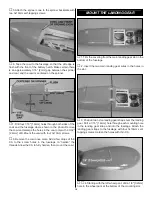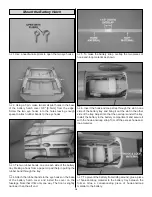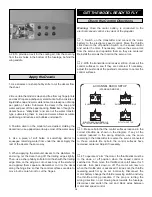
to minimize or eliminate any additional ballast required. If
additional weight is required, use Great Planes [GPMQ4485]
“stick on” lead. A good place to add stick-on nose weight is to
the firewall (don’t attach weight to the cowl-it is not intended
to support weight). Begin by placing incrementally increasing
amounts of weight on the bottom of the fuse over the firewall
until the model balances. Once you have determined the
amount of weight required, it can be permanently attached. If
required, tail weight may be added by cutting open the bottom
of the fuse and gluing it permanently inside.
If moving the motor battery forward or aft will balance the
plane without adding additional weight, mark the battery tray
or the fuselage inside where the forward end of the battery
should be placed. This will allow you to position the battery
correctly before each flight.
❏
4. IMPORTANT: If you found it necessary to add any
weight, recheck the C.G. after the weight has been installed.
❏
1. With the wing level, have an assistant help you lift the
model by the prop shaft and the bottom of the fuse under the
TE of the fin. Do this several times.
❏
2. If one wing always drops when you lift the model,
it means that side is heavy. Balance the airplane by
adding weight to the other wing tip. An airplane that has
been laterally balanced will track better in loops and
other maneuvers.
No matter if you fly at an AMA sanctioned R/C club site or if
you fly somewhere on your own, you should always have
your name, address, telephone number and AMA number
on or inside your model. It is required at all AMA R/C club
flying sites and AMA sanctioned flying events. Fill out the
identification tag on the back cover of this manual and place
it on or inside your model.
Follow the battery charging instructions that came with your
radio control system to charge the transmitter. You should
always charge your transmitter the night before you go flying
and at other times as recommended by the radio manufacturer.
Carefully balance your propeller and spare propellers before
you fly. An unbalanced prop can be the single most
significant cause of vibration that can damage your model.
Not only will motor mounting screws and bolts loosen,
possibly with disastrous effect, but vibration may also
damage your radio receiver and battery.
We use a Top Flite Precision Magnetic Prop Balancer
™
[TOPQ5700] in the workshop and keep a Great Planes
Fingertip Prop Balancer [GPMQ5000] in our flight box.
1. The included motor will benefit from a short “break-in” by
running the motor at full throttle without the propeller for at
least 15 minutes. It is best to run the motor in 5 minute
intervals, allowing the motor to cool between runs. This will
seat the motor brushes on the commutator, insuring that the
motor will provide full power for your first flight and extend
the life of your motor. If you notice a decrease in motor
power after several flights, it may be due to carbon build-up
on the brushes or commutator. To remove this build-up,
repeat the above break-in procedure.
2. The bronze bushings in the motors are self lubricating, but
their life may be extended by applying a very small amount
of light machine oil to the point where the motor shaft
contacts the bushings after every hour or two of run time.
Note: A drop of oil is far too much. You should apply the oil
with a toothpick. Never oil the inside of the motor.
PROPER CARE OF YOUR MOTOR
Balance Propellers
CAUTION: Unless the instructions that came with your
radio system state differently, the initial charge on new
transmitter and receiver batteries should be done for 15
hours using the slow-charger that came with the radio
system. This will “condition” the batteries so that the next
charge may be done using the fast-charger of your choice.
If the initial charge is done with a fast-charger, the
batteries may not reach their full capacity. You may be
flying with batteries that are only partially charged.
Charge the Batteries
Identify Your Model
PREFLIGHT
Balance the Model Laterally
21




































